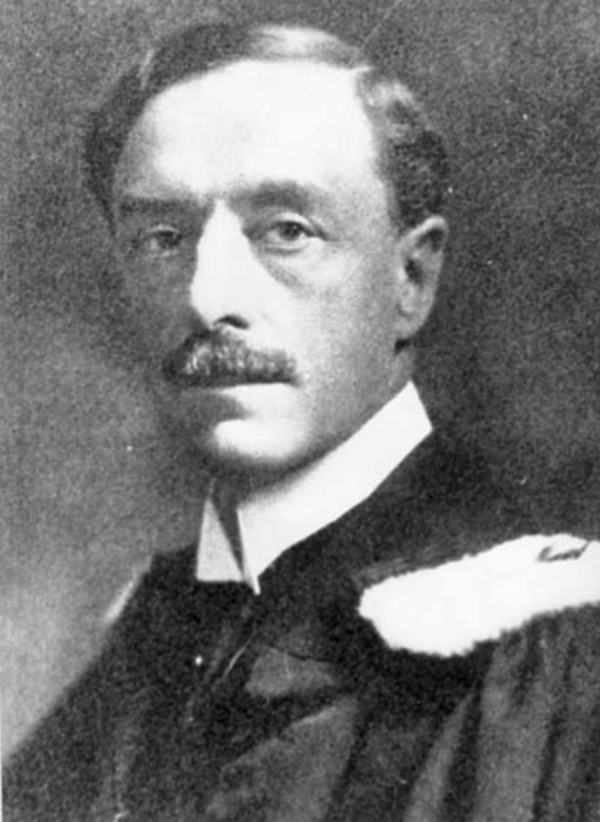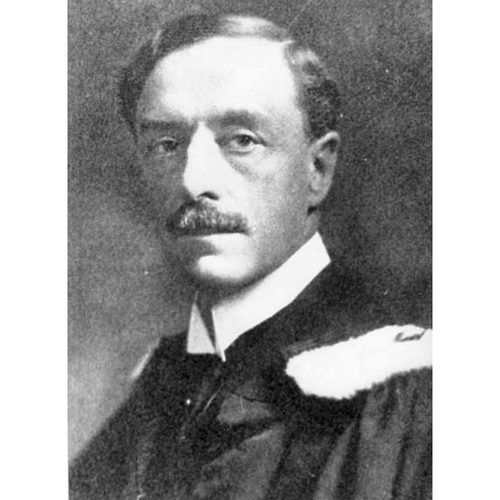
Source: Courtesy of Wikimedia Commons
HARWOOD, LOUIS DE LOTBINIÈRE, physician, gynaecologist, professor, and hospital administrator; b. 27 April 1866, probably in Saint-Michel-de-Vaudreuil (Vaudreuil-Dorion), Lower Canada, son of Henri-Stanislas Harwood, an engineer, and Joséphine Brauneis; m. first 15 April 1891 Marie Masson (d. 16 Oct. 1904) in Montreal, and they had three children; m. secondly there 18 Nov. 1905 Catherine-Delphine Macdonald (d. 16 March 1908); m. thirdly there 21 Oct. 1919 Berthe Brosseau, widow of Charles-Édouard Martin; d. 15 May 1934 in Montreal and was buried two days later in the city’s Notre-Dame-des-Neiges cemetery.
Following his classical studies at the Petit Séminaire de Sainte-Thérèse and the Collège Bourget in Rigaud, Louis de Lotbinière Harwood took up medicine in 1886 at the Montreal campus of the Université Laval, where he obtained his md in 1890. On 24 September of that year he received his professional licence from the College of Physicians and Surgeons of the Province of Quebec. After completing a six-month internship at Notre-Dame Hospital in Montreal, he practised there as a gynaecologist from 1891. In 1903 he left for Europe, where he received further training in his specialty, notably at the Hôpital Broca, in Paris, with Samuel-Jean Pozzi, a renowned surgeon and one of gynaecology’s great pioneers. While working alongside Pozzi, he was instructed in the newly emerging techniques of surgical asepsis.
Upon his return to Notre-Dame Hospital in 1905, Harwood took over from Dr Michel-Thomas Brennan as head of the gynaecology department and held the chair in gynaecology at the Université Laval in Montreal, posts he would retain until his death. The following year he replaced Emmanuel-Persillier Lachapelle* as superintendent of Notre-Dame Hospital and then, in 1917, succeeded him as president of the medical board, a position he filled until 1929. He contributed to the evolution of his specialty by implementing new aseptic procedures in surgery and gynaecology. With his colleagues Oscar-Félix Mercier*, Télesphore Parizeau, and Albert Le Sage, he would take an active part in introducing modern surgical techniques and establishing laboratory medicine at Notre-Dame Hospital.
It was above all as dean of the Montreal School of Medicine and Surgery (which was the faculty of medicine at the Université Laval in Montreal), a post he would hold for the rest of his life, that Harwood left an important mark on the history of medicine in the province of Quebec. When he took over as head of the faculty in the summer of 1918 he proved highly receptive to the ideas for reform expressed by some of his young colleagues. He would help remedy the most obvious lacunae in the faculty, such as the shortage of funds, the insufficient training and supervision of students, the inadequate premises and laboratories, and clinical teaching that was poorly adapted to the number of students.
Owing to Harwood’s efforts, there was an ongoing shift in teaching methods from the 19th-century lecture model to the use of the new standards of medical instruction spreading across North America and Europe. A true reformer, Harwood encouraged the orientation of medical training towards a more advanced clinical approach based on scientific knowledge and the laboratory sciences. Under his guidance the faculty created the position of director of studies and made internship mandatory. In 1921 it established a qualifying year for medical studies, the PCN (physics, chemistry, natural sciences). These courses, given by the faculty of science, allowed the medical program to be reshaped into thorough scientific training. Harwood also introduced, in 1927, an internship that rotated through several medical and surgical departments. The new model afforded students extensive clinical experience. It gave them the opportunity to specialize in a field of their choice and it partially met the needs of the affiliated hospitals.
This was the context in which Harwood, as dean of the Université de Montréal (the name adopted by the Université Laval in Montreal as of 1920) and president of the medical board of Notre-Dame Hospital, launched an initiative remarkable for the times: the construction of a genuine university hospital. The idea was to set up a new university hospital facility where research and teaching would be closely linked; it would not only allow in the long term the establishment of a close relationship between the basic medical sciences and clinical research, but it would also serve in the short term to attract professors from Europe and the United States.
The enterprise, which got under way in 1923, involved putting up near the new Notre-Dame Hospital (then under construction) a university building that would house laboratories, a library, classrooms, a museum, and administrative offices. It came to nothing for lack of financial support from the Rockefeller Institute for Medical Research, which chose at that time to invest in improving clinical teaching and promoting laboratory work. But the project initiated in 1924 to erect the buildings of the Université de Montréal campus on Mount Royal revived the scheme.
A study committee, consisting of Harwood, assistant dean Télesphore Parizeau, chemistry professor Georges-Hermyle Baril, and architect Ernest Cormier*, was formed to come up with a blueprint for the new hospital. In 1927 they went to New York City to draw up the plans for a modern university hospital complex with the director of the Rockefeller Institute for Medical Research, and they then visited the large American faculties of medicine at universities such as Harvard, Yale, Columbia, Johns Hopkins, and Western Reserve, and the University of Pennsylvania. The Rockefeller institute’s support was important: it awarded major grants to medical faculties that wanted to strengthen the connection between the basic medical sciences and clinical research by building new facilities. The large-scale project, which aimed to create the first university medical centre in the province of Quebec, would encourage such ties. In the end, the faculty and university authorities decided to annex the faculty and the hospital to the main building of the university institution proposed for the Mount Royal site and to provide them with the most up-to-date teaching and medical equipment. The plans were approved and work began in 1928. The Great Depression of the 1930s put a temporary halt to construction. At that point the foundations had been reinforced and the exterior walls erected. The building would not be opened until 3 June 1943 and it would not include the university hospital, the development costs being considered too high. But because of the close links that Harwood had forged with the authorities of the Rockefeller institute, he was able to obtain generous grants that financed the qualifying year for medical studies and the equipping of the laboratories.
Louis de Lotbinière Harwood had also facilitated a closer relationship between his faculty and the faculty of science. The inauguration in 1923 of the Institut du Radium, set up by Joseph-Ernest Gendreau* who worked with both faculties, exemplifies this collaboration. The faculties’ combined efforts, spurred by the initiative and dynamism of Brother Marie-Victorin [Kirouac*], Harwood, and biology professor Louis-Janvier Dalbis, also put the Université de Montréal at the centre of a major movement that sought to foster the teaching, popularization, and practical application of the sciences. In 1922 the movement led to the creation of the Société de Biologie de Montréal, whose president was Dr Arthur Bernier*, professor of bacteriology at the faculty of medicine, and then, on 15 May 1923, to the establishment of the Association Canadienne-Française pour l’Avancement des Sciences. As a co-founder of these two important organizations, Harwood made a significant contribution to the evolution of a francophone scientific and biomedical movement.
Louis de Lotbinière Harwood wrote a few articles, now rare, published mainly in L’Union médicale du Canada (Montréal), which include: “Grossesse extra-utérine,” 30 (1901): 521–31; “Les tendances de la gynécologie moderne,” 33 (1904): 509–15; “Tératome solide de l’ovaire avec grossesse concomitante,” 54 (1925): 747–55, written in collaboration with several authors; and “Fibro-myome interstitiel du col utérin,” 61 (1932): 305–8, written with L.‑A. Magnan.
Arch. de l’Hôpital Notre-Dame (Montréal), Procès-verbaux du bureau médical, 1890–1934. BANQ-CAM, CE601-S33, 15 avril 1891; CE601-S51, 29 avril 1866. FD, Notre-Dame (Montréal), 18 nov. 1905, 17 mai 1934; Saint-Jacques, cathédrale de Montréal [Saint-Jacques-le-Majeur], 21 oct. 1919. Univ. de Montréal, Div. des arch., E 38 (faculté de médecine), procès-verbaux de l’École de Médecine et de Chirurgie de Montréal/Faculté de médecine de l’Univ. Laval à Montréal, 1905–20; procès-verbaux du conseil de la faculté de médecine de l’Univ. de Montréal, 1920–34; Règlements pour internat de 5e année, 1927. Le Devoir, 15, 16, 17 mai 1934. BCF, 1933: 308. E.‑P. Benoît, “In memoriam: Louis de Lotbinière-Harwood, doyen,” L’Union médicale du Canada, 63 (1934): 523–30. College of Physicians and Surgeons of the Prov. of Que., Medical reg. (Montreal, 1895). École de Médecine et de Chirurgie de Montréal/Faculté de médecine de l’Univ. Laval à Montréal, Annuaire, 1905–20 (copies held at Univ. de Montréal, Div. des arch., E 38). Léon Gérin-Lajoie, “Le professeur Louis de Lotbinière-Harwood: un hommage,” L’Union médicale du Canada, 63 (1934): 627–28. Denis Goulet, Histoire de la faculté de médecine de l’université de Montréal, 1843–1993 (Montréal, 1993). Denis Goulet et al., Histoire de l’hôpital Notre-Dame de Montréal, 1880–1980 (Montréal, 1993). Hôpital Notre-Dame, Rapport annuel (Montréal), 1890–1929, 1934. L.‑A. Magnan, “À mon maître le professeur Louis de Lotbinière-Harwood,” L’Union médicale du Canada, 63 (1934): 629–33. Univ. de Montréal, Faculté de médecine, Directory, 1920–34.
Cite This Article
Denis Goulet, “HARWOOD, LOUIS DE LOTBINIÈRE,” in Dictionary of Canadian Biography, vol. 16, University of Toronto/Université Laval, 2003–, accessed January 1, 2026, https://www.biographi.ca/en/bio/harwood_louis_de_lotbiniere_16E.html.
The citation above shows the format for footnotes and endnotes according to the Chicago manual of style (16th edition). Information to be used in other citation formats:
| Permalink: | https://www.biographi.ca/en/bio/harwood_louis_de_lotbiniere_16E.html |
| Author of Article: | Denis Goulet |
| Title of Article: | HARWOOD, LOUIS DE LOTBINIÈRE |
| Publication Name: | Dictionary of Canadian Biography, vol. 16 |
| Publisher: | University of Toronto/Université Laval |
| Year of publication: | 2017 |
| Year of revision: | 2017 |
| Access Date: | January 1, 2026 |



